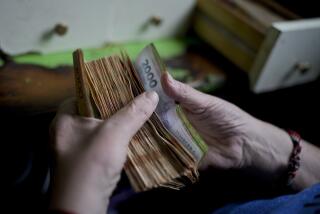Mexico to Issue New Note That Simplifies Peso
- Share via
MEXICO CITY — In a move to further stabilize the Mexican economy, the government has announced plans to simplify its national currency by replacing its 1,000-peso note with a new one-peso note next January.
President Carlos Salinas de Gortari sent the initiative to Congress late Thursday. The ruling-party-dominated Legislature is certain to adopt the new currency, aimed at boosting confidence in the economy and simplifying financial transactions.
“From a psychological point of view, the government wants to send a message to the nation that we are leaving the inflationary era behind,” said Abel Beltran del Rio, an economist with Ciemex-Wefa, a consulting firm that specializes in Mexico.
The government will begin issuing the new coins and bills on Jan. 1, 1993. During a transition period, both the new and old currencies will be accepted. The old 1,000-peso coin will be equivalent to one new peso.
Officials did not announce the new exchange rate, but economists said they do not expect the government to devalue the new peso. At the current exchange rate, the U.S. dollar would be equal to about 3.1 pesos.
“This makes the peso look like a stronger currency, as long as people do not think it is a devaluation,” a Western diplomat said. “This sends the message that Mexico is strong again.”
By announcing the plan six months in advance, the government apparently hoped to avoid a negative impact on the stock market and to prepare the public for the new money.
Further, during the transition--as the new peso is put into circulation--prices are to be posted in new and old pesos in an attempt to prevent merchants from using the switch to sneak in price increases.
The government hopes the new currency will help bring down inflation, still running at more than 16% annually. Economists predict that inflation will be about 10% to 12% by the end of the year and warn that financial markets will grow skittish if it is more than that.
Sustained double-digit inflation would create pressure for a devaluation.
“The new peso will have a deflationary effect in the short term because people will feel poorer,” said economist Rogelio Ramirez de la O. “It will make people more aware that small price increases are not permissible.”
The move to drop three zeros from the peso had been predicted for several years. South American countries such as Argentina and Brazil took similar steps as part of their economic shock programs, but were still unable to control inflation.
Mexico opted to make the change after revamping its economy.
“You have to pick the right time to knock off zeros, and this is the right time,” Ramirez de la O added. “The economy is not growing (as fast), there is no fiscal deficit and the government is reducing its indebtedness. The conditions are appropriate.”
The government announced earlier this week that it had canceled $7 billion or nearly 9% of its foreign debt. The $73.6-billion debt will equal about 29% of gross domestic product by the end of the year--compared to 74% in 1988.
As part of its restructuring program, the government has sold many of its major state-owned industries, slashed subsidies to producers and cut federal spending. It has also held down wage increases, prompting a cartoon in the daily newspaper La Jornada in which one worker tells another, “This plan began three years ago when they took three zeros off of our salaries.”
The new peso will simplify financial transactions that now run into billions and trillions of pesos--figures that do not fit on a common calculator. The new peso coin also will be smaller than the bulky 1,000-peso coin that is about the size of a half-dollar but worth about 30 cents. The new peso will be divided into 100 cents.
More to Read
Sign up for Essential California
The most important California stories and recommendations in your inbox every morning.
You may occasionally receive promotional content from the Los Angeles Times.













